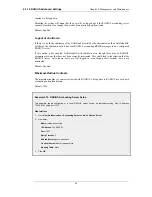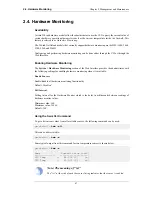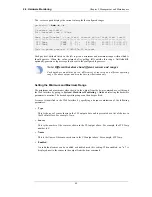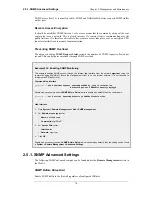
To reset the NetDefend DFL-210, 260, 260E, 800, 860 and 860E models, hold down the reset button
located at the rear of the unit for 10-15 seconds while powering on the unit. After that, release the
reset button and the unit will continue to load and startup with its default factory settings.
The IP address 192.168.1.1 will be assigned to the LAN interface on the DFL-210, 260, 800 and
860 models. The IP address 192.168.10.1 is assigned to the LAN interface on the DFL-260E and
DFL-860E models.
Reset Procedure for the NetDefend DFL-1600, 1660, 2500, 2560 and 2560G
To reset the DFL-1600, 1660, 2500, 2560 and 2560G models, press any key on the keypad when the
Press keypad to Enter Setup message appears on the front display. Now, select the Reset firewall
option and confirm by selecting Yes. Then wait for the reset process to complete after which the unit
will startup with its default factory settings.
The IP address 192.168.1.1 will be assigned to the default management interface LAN1 on the
DFL-1600 and DFL-2500 models. The management interface IP address for the DFL-1660,
DFL-2560 and DFL-2560G models will default to 192.168.10.1.
The default IP address factory setting for the default management interface is discussed further in
Section 2.1.3, “The Web Interface”.
Warning: Do NOT abort a reset to defaults
If the process of resetting to factory defaults is aborted before it finishes, the
NetDefend Firewall can then cease to function properly with the complete loss of all
stored user data.
End of Life Procedures
The restore to factory defaults option should also be used as part of the end of life procedure when a
NetDefend Firewall is taken out of operation and will no longer be used. As part of the
decommissioning procedure, a restore to factory defaults should always be run in order to remove
all sensitive information such as VPN settings.
As a further precaution at the end of the product's life, it also recommended that the memory media
in a NetDefend Firewall is destroyed and certified as destroyed by a suitable provider of computer
disposal services.
2.7.3. Restore to Factory Defaults
Chapter 2. Management and Maintenance
78
Summary of Contents for DFL-1600 - Security Appliance
Page 27: ...1 3 NetDefendOS State Engine Packet Flow Chapter 1 NetDefendOS Overview 27 ...
Page 79: ...2 7 3 Restore to Factory Defaults Chapter 2 Management and Maintenance 79 ...
Page 146: ...3 9 DNS Chapter 3 Fundamentals 146 ...
Page 227: ...4 7 5 Advanced Settings for Transparent Mode Chapter 4 Routing 227 ...
Page 241: ...5 4 IP Pools Chapter 5 DHCP Services 241 ...
Page 339: ...6 7 Blacklisting Hosts and Networks Chapter 6 Security Mechanisms 339 ...
Page 360: ...7 4 7 SAT and FwdFast Rules Chapter 7 Address Translation 360 ...
Page 382: ...8 3 Customizing HTML Pages Chapter 8 User Authentication 382 ...
Page 386: ... The TLS ALG 9 1 5 The TLS Alternative for VPN Chapter 9 VPN 386 ...
Page 439: ...Figure 9 3 PPTP Client Usage 9 5 4 PPTP L2TP Clients Chapter 9 VPN 439 ...
Page 450: ...9 7 6 Specific Symptoms Chapter 9 VPN 450 ...
Page 488: ...10 4 6 Setting Up SLB_SAT Rules Chapter 10 Traffic Management 488 ...
Page 503: ...11 6 HA Advanced Settings Chapter 11 High Availability 503 ...
Page 510: ...12 3 5 Limitations Chapter 12 ZoneDefense 510 ...
Page 533: ...13 9 Miscellaneous Settings Chapter 13 Advanced Settings 533 ...
















































